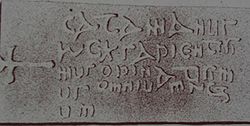| St. Cadwaladr Church | |
|---|---|
Welsh: Eglwys Ael | |
 St. Cadwaladr Church | |
Location in Anglesey | |
| 53°11′45″N4°25′15″W / 53.1959°N 4.4209°W | |
| OS grid reference | SH 383 692 |
| Location | Llangadwaladr |
| Country | Wales |
| Denomination | Church in Wales |
| Previous denomination | Roman Catholic |
| Website | churchinwales.org- St. Cadwaladr, Llangadwaladr |
| History | |
| Former name(s) | Eglwys Ael |
| Status | Church |
| Founded | 615 |
| Dedication | Cadwaladr |
| Associated people | Meyrick family of Bodorgan Owen Family of Bodowen |
| Architecture | |
| Functional status | Active |
| Heritage designation | Grade I |
| Designated | 30 January 1968 |
| Style | Late Decorated |
| Groundbreaking | 600s |
| Completed | 1856 |
| Specifications | |
| Length | 44.25 ft (13.49 m) |
| Nave width | 16.75 ft (5.11 m) |
| Administration | |
| Province | Wales |
| Diocese | Bangor |
| Episcopal area | North West Wales |
| Archdeaconry | Archdeacon of Anglesey |
| Deanery | Synod Ynys Mon |
| Benefice | Bro Cadwaladr parish |
| Clergy | |
| Archbishop | Andy John |
| Vicar(s) | The Reverend Canon E C Williams |
| Priest(s) | The Reverend E R D Roberts |
| Archdeacon | John Harvey |
 | |
St Cadwaladr's Church (Welsh : Eglwys Ael) is a Grade I listed church in Llangadwaladr, Anglesey. The location of the current church was established in the 7th century by the Kings of Gwynedd, after whom the church is named, King Cadwaladr. The Church standing today was built in the 'T' shape perpendicular style. The nave is dated to the 12th to early 13th century and the chancel to the 14th. Later the chapels were built, the north in 1640 and the southern Bodowen Chapel in 1661. Then, during 1856 the church underwent restoration, at which time the south porch was added. [1] [2] [3]














